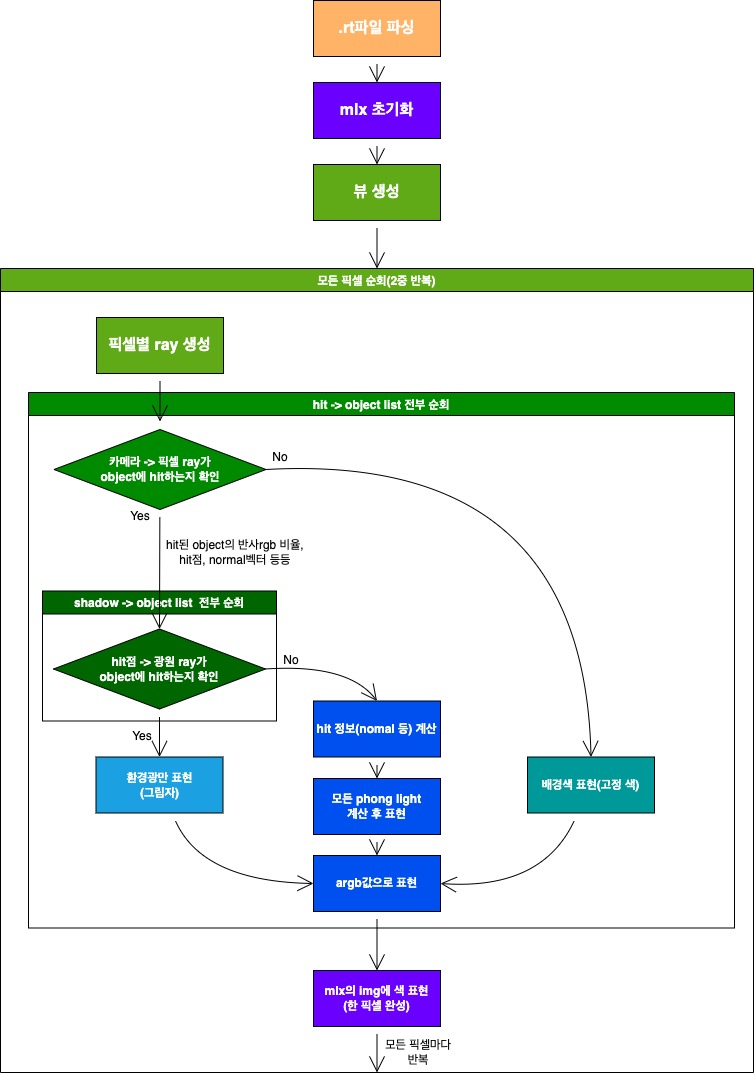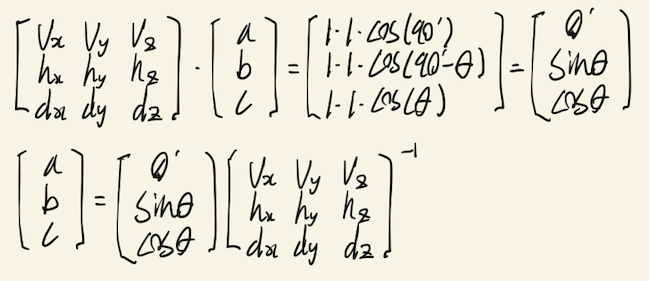MiniRT 동작 및 추가 개념 정리
이전 과제에서 다루었던 view 및 light(phong)개념은 생략
1. 전체적인 동작 방식

2. 구체적인 동작방식(자랑)
2.1 object 구조체 전달 방식
typedef struct s_object // 부모 클래스 같은 역할.
{
int type;
t_ratio ratio_reflect;
struct s_object *next;
} t_object;
typedef struct s_sphere
{
int type;
t_ratio ratio_reflect;
struct s_object *next;
t_point center;
double r;
} t_sphere;
typedef struct s_plane
{
int type;
t_ratio ratio_reflect;
struct s_object *next;
t_point point;
t_vec normal;
double r;
} t_plane;
typedef struct s_cylinder
{
int type;
t_ratio ratio_reflect;
struct s_object *next;
t_point point;
t_vec normal;
double r;
double height;
} t_cylinder;
typedef struct s_cone
{
int type;
t_ratio ratio_reflect;
struct s_object *next;
t_point point;
t_point c;
t_vec normal;
double r;
double height;
double theta;
} t_cone;
...
t_hit hit_object(t_ray ray, t_object *objects, int is_shadow)
{
t_hit min_ret;
t_hit tmp;
t_object *iter;
iter = objects;
min_ret.t = INF;
min_ret.is_hit = FALSE;
while (iter != NULL)
{
if (objects->type == TYPE_S)
temp = hit_sphere(ray, (t_sphere *)objects);
else if (objects->type == TYPE_P)
temp = hit_plane(ray, (t_plane *)objects);
else if (objects->type == TYPE_C)
temp = hit_cylinder(ray, (t_cylinder *)objects);
else
temp = hit_cone(ray, (t_cone *)objects);
if (tmp.is_hit == TRUE)
{
if (is_shadow == TRUE && (tmp.t >= EPSILON && tmp.t < min_ret.t))
min_ret = tmp;
else if ((tmp.t >= EPSILON && tmp.t < min_ret.t))
min_ret = tmp;
}
iter = iter->next;
}
return (min_ret);
}
파싱한 각 오브젝트는 t_object형으로 cast된 리스트로 전달된다. t_object형은 각 object들이 앞부분에 가지는 공통 요소(type, ratio_reflect, next)들 구조체이다.
c++형태로 표현하면 t_object는 t_sphere, t_plane, t_ctlinder…들의 부모클래스처럼 사용 가능하다.
따라서 object를 순회할때 t_object형의 리스트로 순회된다. 그리고 각 오브젝트의 반별 함수에 type에 따라 적합한 object형으로 cast되어 전달된다.
2.2 화면 회전
- 정면으로 상하 θ도 회전 = z축(vertical) θ도 회전, y축(camera_direction) θ도 회전, x(horizon) 회전 안함.
- 정면에서 좌우 θ도 회전 = z축(vertical) 회전 안함, y축(camera_direction) θ도 회전, x(horizon) θ도 안함.
2.2.1 상하 θ도 회전
(vx, vy, vz) = 변환 전 vertical 벡터
(hx, hy, hz) = 변환 전 horizon 벡터
(dx, dy, dz) = 변환 전 camera_direction 벡터
(a, b, c) = 변환 후 camera_direction
-
(vx, vy, vz) · (a, b, c) = 1 1 cos(90’ + θ) -
(hx, hy, hz) · (a, b, c) = 1 1 cos(90’) -
(dx, dy, dz) · (a, b, c) = 1 1 cos(θ)

위의 식을 행렬식으로 표현하면
2.2.2 좌우 θ도 회전
(vx, vy, vz) = 변환 전 vertical 벡터
(hx, hy, hz) = 변환 전 horizon 벡터
(dx, dy, dz) = 변환 전 camera_direction 벡터
(a, b, c) = 변환 후 camera_direction
-
(vx, vy, vz) · (a, b, c) = 1 1 cos(90’) -
(hx, hy, hz) · (a, b, c) = 1 1 cos(90’ - θ) -
(dx, dy, dz) · (a, b, c) = 1 1 cos(θ)

2.2.3 종합
3*3역행렬을 구하는 함수를 만들고, 위에서 구한 식들을 곱하여, camera의 direction방향을 재설정하였다. 이후 다시 처음 픽셀부터 하나씩 계산하여 회전된 각도의 화면을 출력한다.